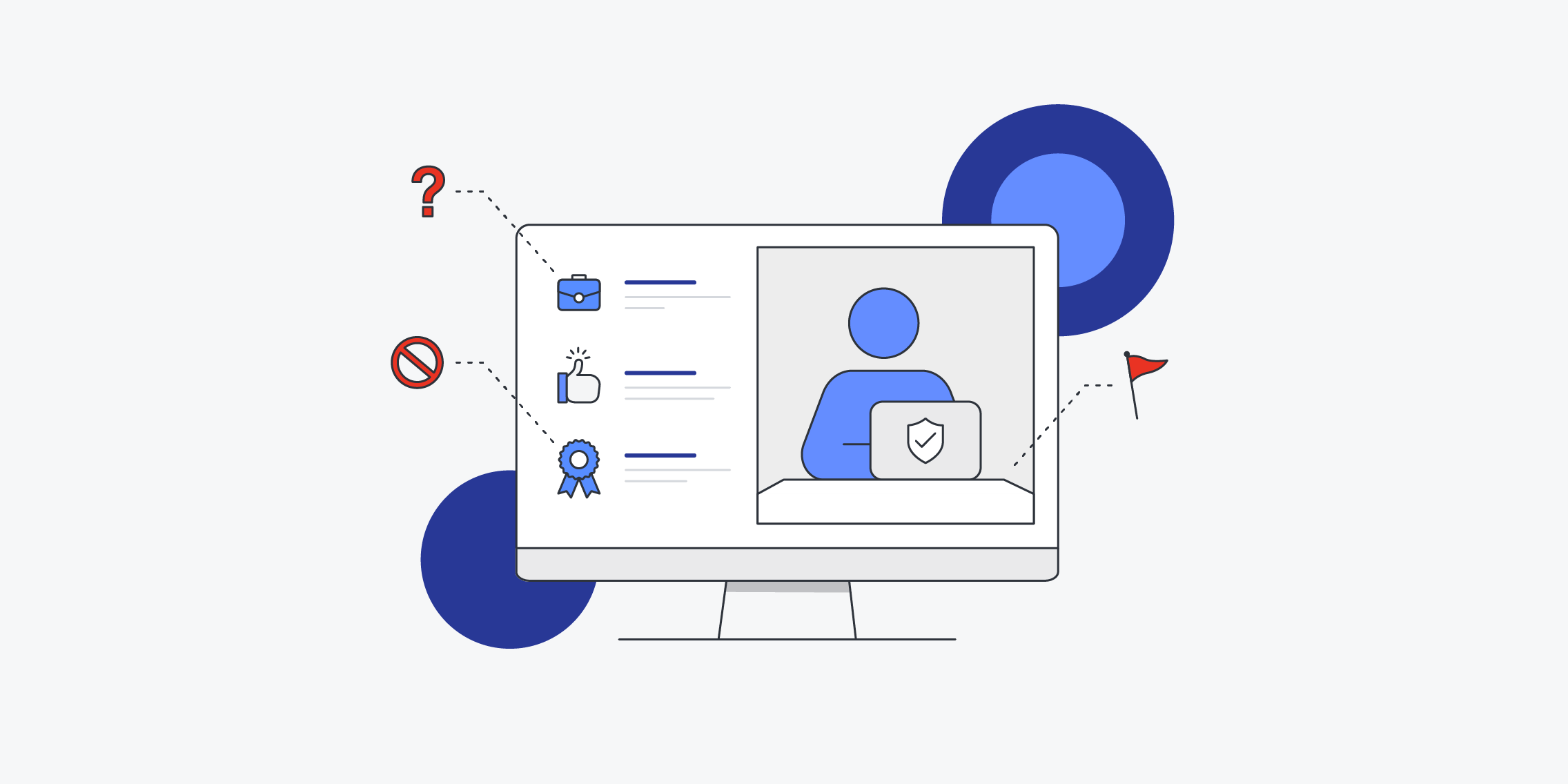Many online UX academies—especially boot camp-style courses—offer job placement guarantees after the completion of coursework.
Their promise is simple: if you don’t find a job in the field of UX within six months, they’ll refund your course fees.
When you’re transitioning into a new career, the guarantee of a job is incredibly enticing.
But if this sounds too good to be true, it’s because it is. Universities don’t offer job guarantees, so how could online boot camps?
In this article, we’ll explain:
- Why UX job guarantees are insincere
- How their terms and conditions are near-impossible to satisfy
- Why they benefit course providers, not students
- How to land a UX job without a guarantee
Then, we’ll explain how 79% of our students at the UX Design Institute go on to get jobs in UX—without a job guarantee.
Why UX job guarantees are dishonest
Here’s why you shouldn’t put too much stock in UX job guarantees.
1. They prey on two big vulnerabilities.
Job guarantees take advantage of the two biggest vulnerabilities a career switcher has:
- the fear of not landing that first role; and
- the fear of wasting money.
If you’re hesitant to invest in a course because it may not lead to a job, the easiest way to convince you to sign up is to provide you with a financial safety net.
But these job guarantees are not safety nets—they’re lures. They’re advertised front and center on the home page of many course providers’ websites as a marketing tactic.
Their goal is to take your attention away from the factors that will land you your dream job—such as the quality of the education and legitimacy of the qualifications—and instead place your attention on the potential risks of losing time and money.
2. Their terms and conditions are challenging to satisfy.
The biggest red flag with UX job guarantees is the complexity of the fine print.
The terms and conditions are designed to make it as difficult as possible to reclaim your course fees in the event of not getting a job.
We strongly encourage you to check them out for yourself, but we dug through the terms and conditions of the four most popular UX boot camp providers to save you some time.
Here’s a review of the most challenging terms to satisfy.
Living in a pre-approved city: Of the four providers, two require you to live in a major US city—even if you’re applying for remote roles. The third provider has an additional list of 15 eligible cities outside the US. The most generous location terms allow you to reside in any city with a population above 200,000 in the United States, Canada, EU, UK, Australia, or New Zealand.
One goes as far as to specify a maximum commuting time of one hour during rush-hour traffic.
Not relocating during your job search: Another common catch is that you’re not allowed to move cities during the job search period, as it may impact the momentum of your search.
Applying for an impossible amount of roles: Course providers require you to apply to between four and ten roles per week. In most cases, applying to remote roles does not count toward these totals.
One provider even requires that at least three applications per week come from personal connections.
High networking demands: Course providers require you to make five to seven new career connections per week and two informational interviews per month.
Limited role choice: For all providers, you must accept the first job offer you get or lose the job guarantee. This can include part-time or temporary roles. For example:
“If you receive an offer of any type, paid or unpaid, you must let us know by completing the “I’m Hired” form which you will find on your student dashboard. Any paid design role with >20 hours/week for 4 or more weeks of work will count as a qualifying offer, rendering the reimbursement null and void. Failure to report a qualifying offer is a breach of the Career Services Code of Conduct.”
Previous education or experience: One provider requires you to have a Bachelor’s degree or previous working experience in the UX field:
“You must have at least 1 year of documented professional experience in one of the following related fields, OR hold a bachelor’s degree in one of the following related fields: user research, human/computer interaction, producing/managing visual content, or UI design.”
Strict communication requirements: All four providers have strict requirements on how quickly you must communicate with your career advisor—giving you between 24 to 72 hours to reply to all communication. All course providers also require regular check-ins with career specialists to track your progress.
Miss an email or a meeting, and you can lose your guarantee.
Reporting on all of the above: You’re also forced to track all of the above activity on a weekly basis and report it to your career advisor.
Even if you should satisfy all of the above, there are clauses that allow the course provider to push back the guarantee deadline by up to 12 months if there are any local or global trends that increase unemployment rates—such as wars, pandemics, natural disasters, or economic crises.
The big takeaway: These clauses are designed to protect the course provider, not the student.
3. They distort the relationship between the career team and the student.
The side effect of the complex terms and conditions is that they muddy the relationship between the course provider and the student.
Most of the burden of the guarantee is placed on the student. They’re the ones who have to complete all the applications and make personal connections.
Career advisors are incentivized to protect the interests of the course provider. As long as they present you with offers—even if they’re not suitable for you—they’re doing their jobs.
Rather than focusing on helping the student land their dream job, even the most well-intentioned career advisors have to spend their time monitoring whether or not the student has complied with the terms and conditions.
The relationship becomes more like administrative policing rather than career support.
How do we land you a job without a guarantee?
At the UX Design Institute, we don’t offer job guarantees. They just don’t match our values.
Instead, we focus on providing high-quality education and career support. We want our students to have the skills, confidence, mindset, and language to become successful UX designers.
Because we focus on supporting our students instead of holding them to terms and conditions, 79% of students who complete their coursework and create portfolios at the UX Design Institute go on to get jobs in the field of UX.
Here are some practical things we do to land you your first role without a taxing guarantee.
1. We provide recognized qualifications
Unlike many other course providers, our UX design and UI design courses are university credit-rated (by Glasgow Caledonian University).
This globally recognized standard carries more weight and trust than a typical online certificate of completion. This makes them more credible in the eyes of recruiters and employers, who are especially skilled at spotting low-quality certifications.
Plus, should you ever want to complete a relevant university degree, the credits can be applied toward your diploma.
2. We teach the most in-demand skills
Many online courses are created by academics or former industry professionals who left the industry to sell courses. Because the UX industry changes so quickly, these courses quickly become outdated.
To ensure you’re learning the most in-demand skills in the UX industry, our courses are steered by an Industry Advisory Council.
The council is made up of UX professionals at major technology companies like Hubspot, LinkedIn, and Intercom, startups and agencies that use UX in their design process, and UX recruitment agencies.
By consulting directly with UX professionals and the people who employ them, we stay on top of industry trends and best practices, making you more employable.
3. We help you build a portfolio
As part of your coursework, you will build a portfolio of work that proves you have the skill set to work at a professional level. You’ll get to work on a real project where you get to practice all the main UX techniques, culminating with a capstone project.
Then, we’ll help you package that work into a portfolio that shows off not just a nice-looking prototype, but also all the research, sketching, and design work that went into the project.
4. Our careers team’s only job is to support you
When it comes to landing your first job in UX, the coursework is often the easy part. The real challenge is in applying and interviewing for jobs.
Getting a job comes down to great support.
While other course providers are incentivized to hold you to job guarantees, our careers team is always there to support you.
Our career support services team—made up of former UX recruiters—helps you get ready for the job market by helping you:
- prepare your portfolio
- put your CV/resume together
- prepare for interviews
And rather than throwing any job at you or catching you on terms and conditions, our team gets to know you as a person so they can help you craft your story and find a job that’s a great fit for you.
5. We offer a supportive community
We also provide our students with a thriving community where they can continue to develop their knowledge and understanding of UX after their coursework.
Our huge Slack community of UX Design Institute graduates offers a supportive, lively environment where you can learn from other high-caliber peers who are in the same boat as you.
We also host a regular webinar series—UX Insiders—where you can hear from UX professionals who have already made the transition into the industry.
We’ve heard UX professionals from Google, Meta, Miro, Headspace, Duolingo, and more share how they got their first jobs in UX, what a typical day in the life of a UX designer looks like, and what they look for in entry-level candidates when they’re hiring.
6. We connect you with employers
Because of the large demand for UX, lots of companies contact us looking for skilled graduates.
Our Hire our Alumni network creates a bridge between these companies and our alumni. By opting into this free service, your CV and portfolio will be made available to all the companies in our worldwide network.
Land a dream job, not just any job
After that, the job search is over to you. But with the support from our careers team, you will be in the best possible position to land your dream job—not just any job.




